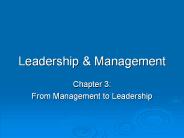E-Leadership - PowerPoint PPT Presentation
1 / 15
Title:
E-Leadership
Description:
E-Leadership Emerging Behavioral and Communication Issues Kehinde Olagoke NIGERIA INSTITUTE OF BUILDING Have a Vision Harness the Talent and skills of Team ... – PowerPoint PPT presentation
Number of Views:1280
Avg rating:3.0/5.0
Title: E-Leadership
1
E-Leadership Emerging Behavioral and
Communication Issues
- Kehinde Olagoke
NIGERIA INSTITUTE OF BUILDING
2
Leadership As we know it!
- Have a Vision
- Harness the Talent and skills of Team members and
clients - Communicate Articulate the Vision to Team
members and your clients - Delegate Function
- Monitor Progress, Mentor Team/Followers/Clients
- Motivate by rewarding achievements and
reprimanding failure to meet the challenges of
the clients.
3
e-Leadership?
- Now significant human interactions are mediated
through - information technology to produce new
organizational form - and new work environment termed E-environment and
the - emerging leadership is labeled as E-leadership
- or Electronic leadership
4
Leadership- Traditional or Electronic Any
connection ?
- The goals of leadership have not changed , but
the e-leader needs to implement those goals
electronically through computer mediated virtual
teams that are dispersed over space and time . - Leadership patterns are beginning to reflect
transition from industrial to post-industrial
society. The new society variously called
information society, is marked by rapid and far
reaching changes in digitalization of information
and communication technology.
5
Why e-leadership?
- The use of information technology over the years
- has been altering the way organizations are
- Conducting their business. As a result new
- organizational form -virtual organization - has
- emerged.
- Leader and followers now communicate
- through E-technologies (telephone, e-mail, chat
- social media and video-conferencing etc).
6
So what is in it for Me?
- Instant direct communication with employees,
customers, suppliers and stakeholders . - Access to clients irrespective of location
- Enhancement of organizational performance by
making use of multi-functional teams - Cost Reduction
- Access to information/greater workforce
connectivity - Rapid response to customers demands
- Increased or Improved Bottom-line as competitive
advantage is enhanced
7
What are we Up Against ?
- Bridging the physical distance between the
leader, his team and clients. - Communicating effectively with widespread team
members who in turn make it simple for the
clients. - Conveyance of enthusiasm and inspiration to
followers and clients electronically - Building of Trust with team members and the
clients you dont see
8
Technology Leadership Transformational
Leadership
- Adaptive Structuration Theory
- - Human actions are guided by structures
Structures are rules and resources that serve as
templates for planning and accomplishing tasks . - Technology creates organizational structures of
which leadership is a part. - Leadership and technology have a recursive
relationship .
9
Practice of e-Leadership
- Be prepared
- Develop New Skills
- Be adaptable to Change/Flexible
- Learn to Re-learn
- Learn to Motivate
- Learn to Build Trust
- Understand the value of e-technologies
- Experiment with ideas
10
e-Leadership and Communication
- Comunication is key in e-leadarship. It takes
place - through information technology.
- Could be verbal, non verbal, Visual , non Visual
etc - The basic responsibilities of the leader do
- not change the only thing that change is how
the - leader can communicate with his people
effectively - while they are not at the same office building.
11
Barriers to e-leadership Communication
- Beliefs/Perception
- Information Overload
- Assumption
12
Overcoming the Barriers of e-leadership
communication
- Knowing when to replace traditional work
processes with virtual ones - Learn about cultural differences, if these could
pose problems - Avoid the use of Jargons
- Avoid language that is confrontational or
Judgmental
13
Audience Analysis
- Analysis- Who is the audience ?
- Understanding- What is the audiences
Knowledge of the subject - Demographics- What is their age , gender
, educational background - Interest- Why are they listening to me ?
- Environment- Where will this document be
/presented - Needs - How can I meet the needs of
the audience - Customization - How can I tailor my work to
meet their needs? - Expectations What would they learn from my
presentation - Note that the results of your audience analysis
that will determine the tool/channel of
communication
14
E-leadership Communication Tools
- Internet Forum Discussion Boards
- Weblogs
- RSS (Really Simple Syndication)
- Social Networking e.g Facebook, Yammer, Twitter,
etc - Conferencing Tools (Video or Telephone) e.g Skype
- Online Chat eg. Yahoo Messenger, Blackberry
- Flash meeting
- Application/Desktop sharing
- Intranet
15
Using Email in Internal/External Communication
- A fairly informal business correspondence with a
set of rules called Netiquette, Digital manners
etc. - Be Concise and Unambiguous
- Be clear and Direct in the Subject Line
- Never think your email is totally Confidential
- If this is made public , would you be comfortable
? - Do not torture your readers with abbreviations
- Use Uppercase for emphasis Only
- Dont start with Dear Sir/Madam
- Use Informal Closing
- Dont send one word emails
- Save a tree !
- Use the address fields with care
- Politely Sign your messages































